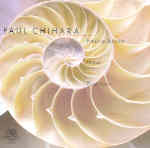Do you enjoy the exotic soundscapes of Tan Dun’s score to the film Crouching Tiger, Hidden Dragon, Messiaen’s stained-glass-color chords, and those sudden whooshes of brass typical of most 1960s adventure/suspense/detective TV shows? Imagine these elements woven together in a tautly structured, breathtakingly orchestrated ballet score, and you’ve got the gist of Paul Chihara’s 1973 Shinju. It’s interesting that this work appeared not long before Chihara began his so-called “second career” as a film, television, and theater composer: clearly his instincts for these mediums were firmly in place.
I’m especially taken with how organically Chihara integrates electronically processed recordings of ancient Japanese song into the orchestral fabric. In his 1971 cello concerto, Wind Song, the soloist’s long lines (stunningly played by Jeffrey Solow) leap in slow, declamatory motion, occasionally broken up by quick, jagged flourishes that lead into snarling brass chords or to single notes suspended in midair, surrounded by active yet discreet percussion rejoinders.
If these two works make their expressive points largely through texture and gesture, the composer’s Forever Escher (from 1993-94) is more line-oriented and tonally conservative. Scored for the unusual combination of string quartet and saxophone quartet, the composition’s rich variety of colors seems governed by contrapuntal rather than timbral considerations. I only read the composer’s program notes after hearing the piece, and I discovered that the quotes from David Raskin’s Laura and Wagner’s Tristan und Isolde indeed were intentional. Wind Song, incidentally, once was available on a hard-to-find Everest LP, and presumably is remastered from the original analog master tape. Shinju is a 1989 recording, while Forever Escher was taped in April, 2001. I have no doubt that the composer is pleased with the vivacity, commitment, and splendid polish these performances bear. Highly recommended.
































